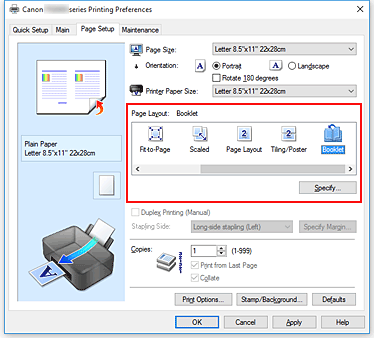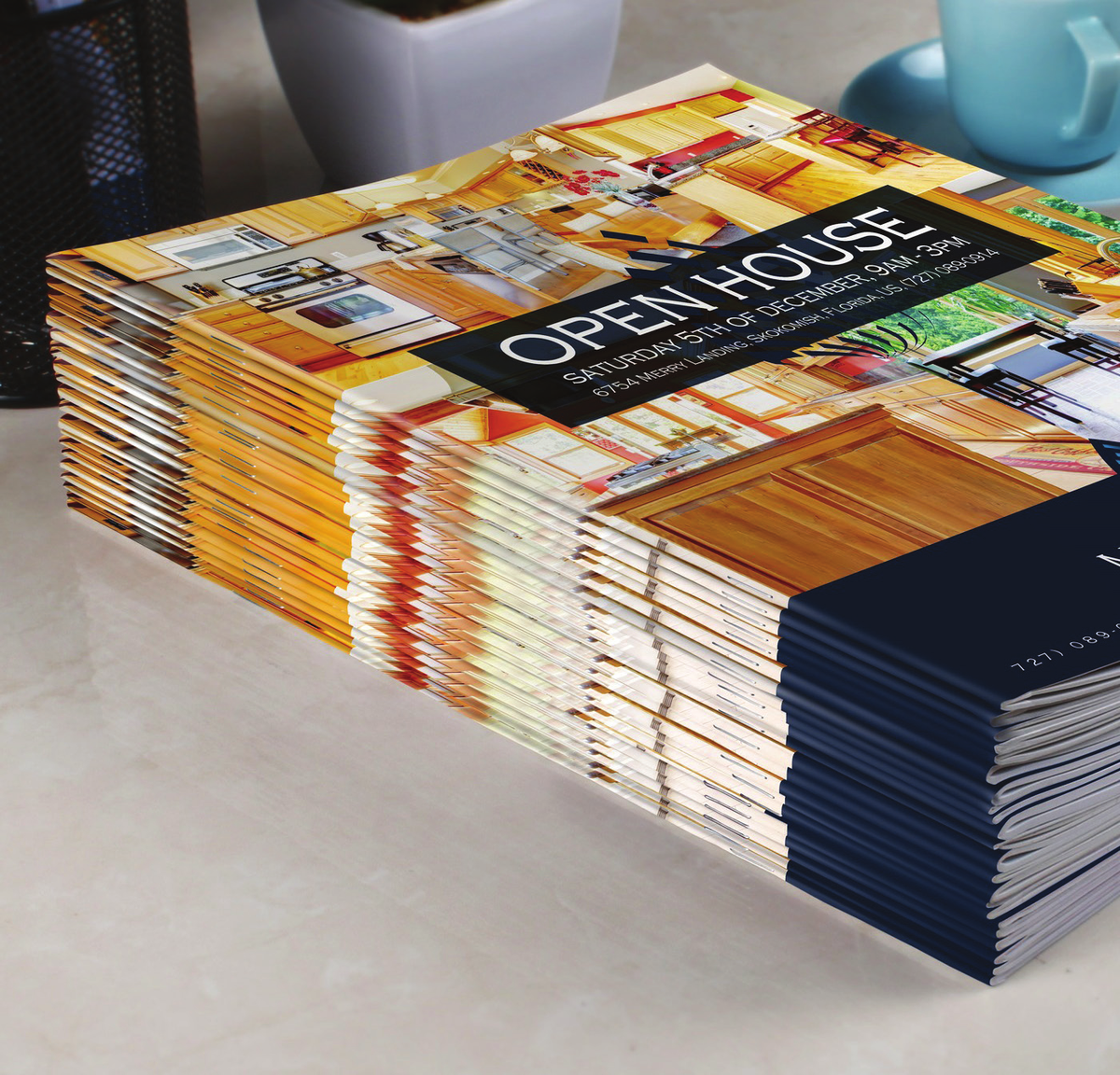The Essential Overview to Recognizing Brochure Printing Options and Techniques
The procedure of pamphlet printing includes numerous factors to consider that can significantly affect the end product. From choosing the appropriate layout and size to comprehending the nuances of binding techniques, each option plays an important role. Additionally, aspects such as paper supply and printing methods more influence the effectiveness of the pamphlet. As one browses these choices, it ends up being crucial to realize how they adjoin and what that means for the overall end result.
Recognizing Booklet Formats and Dimensions
When considering booklet printing, comprehending the various layouts and sizes offered is necessary for accomplishing the wanted presentation. Booklets can be produced in numerous styles, consisting of saddle-stitched, spiral-bound, and perfect-bound, each offering distinct benefits. Common sizes range from standard letter (8.5 x 11 inches) to smaller options like A5 (5.8 x 8.3 inches), permitting versatility based on content and target audience.Selecting the proper dimension can influence both the format and reader interaction. Larger dimensions could fit aesthetically driven web content, while smaller sized layouts may be a lot more user-friendly and portable. In addition, the variety of web pages affects the choice of binding technique, as thicker brochures may need stronger bindings. Inevitably, comprehending these elements permits for a more customized approach, making sure that the final product aligns with the desired message and aesthetic, improving the general efficiency of the communication.
Picking the Right Paper Stock

Binding Methods: Considerations and options
When it concerns binding methods for booklets, a number of choices are available, each with distinctive benefits. Saddle stitch binding uses an affordable solution for thinner brochures, while excellent binding strategies give an even more refined try to find thicker publications. Wire-O binding stands apart for its resilience and ease of usage, making it suitable for files that need versatility.
Saddle Stitch Binding
Saddle stitch binding offers a economical and functional option for putting together brochures, making it a preferred choice amongst publishers and companies. This binding approach involves folding sheets of paper in fifty percent and stapling them along the fold line, producing a neat and orderly look. Commonly suitable for pamphlets with a reduced page count, saddle stitching is excellent for publications, pamphlets, and educational materials. The simplicity of this technique enables for quick manufacturing and is often favored for short runs or marketing things. It is important to note that saddle stitch binding may not be suitable for thicker brochures, as the back might not hold up under enhanced weight. Overall, it stays a reputable alternative for many printing jobs.
Perfect Binding Methods
Perfect binding is a widely utilized technique that supplies a specialist and refined surface to magazines and pamphlets. This technique includes gluing the pages together at the back utilizing a solid adhesive, enabling a tidy edge and the capability to hold a larger variety of pages contrasted to saddle sewing. Perfect binding is especially ideal for thicker pamphlets, such as magazines and annual reports, where a tough, flat back is wanted. Additionally, it supplies the option for a printed cover that can be made to enhance aesthetic appeal. Factors to consider such as web page matter, paper weight, and the intended use of the booklet should be taken right into account, as they can affect sturdiness and total quality.
Wire-O Binding Options
Wire-O binding, recognized for its toughness and versatility, offers an excellent option for booklets that require easy page turning and an expert appearance. This binding technique utilizes a series of steel loops that hold pages securely, allowing them to lie level when open. It is especially ideal for discussions, guidebooks, and catalogs as a result of its durable nature. Wire-O binding is available in different colors and diameters, suiting various page counts and densities. In addition, it permits the inclusion of covers and tabs, boosting the pamphlet's overall aesthetic. Considerations for Wire-O binding include the choice of cord shade, the size of the loops, and the level of modification preferred, all of which can profoundly affect the end product's appearance and performance.
Digital vs. Offset Printing: Which Is Best for You?
When selecting a printing approach for pamphlets, comprehending the differences between digital and balance out printing is necessary. Digital printing utilizes contemporary technology to create high-quality prints rapidly and economically, making it suitable for brief runs or tasks calling for fast turnaround times. It enables customization, supplying the capability to publish on-demand with very little waste.In contrast, balance out printing is a conventional method that masters generating large amounts with consistent high quality. It entails transferring ink from a plate to a rubber covering, then to the paper, which leads to accurate information and vibrant colors. Balance out printing typically requires longer configuration times and is a lot more cost-effective for larger volumes.Ultimately, the option in between electronic and offset printing depends on task requirements, budget plan, and wanted amount. For tiny, time-sensitive projects, digital might be the most effective option, while countered might be preferable for larger, top quality manufacturings.

Creating Your Brochure: Tips and Ideal Practices
When making a brochure, mindful attention to design, typeface option, and shade use can greatly boost its efficiency. A well-structured layout overviews the visitor's eye, while suitable fonts assure readability and communicate the preferred tone. Additionally, efficient use of shade can stimulate emotions and emphasize crucial details, making the general design more impactful.
Choosing the Right Format
Exactly how can one effectively pick the ideal design for a brochure? It is necessary to review the booklet's objective and target audience. A clean, arranged design improves readability and involvement. Making use of a grid system can assist in lining up components continually, creating a specialist appearance. In addition, incorporating visual pecking order through differing sizes and positionings of images and message can guide the viewers's eye and stress key details. It is likewise vital to leave sufficient white room, which stops overcrowding and enables for far better focus. Ultimately, look at this website examining various designs with mock-ups can offer understanding right into just how the design carries out in real-world circumstances, making certain that the last product satisfies both visual and functional needs.
Choosing Ideal Fonts
An appropriate typeface can greatly improve the total layout of a pamphlet, complementing the layout and reinforcing the content's message. The choice of font styles need to think about readability, specifically for body text, as it guarantees the information comes to all viewers. Sans-serif typefaces are typically favored for digital styles, while serif font styles can offer a standard feel in published materials. It's suggested to restrict font options to two or 3 to maintain visual comprehensibility. In addition, font style size plays an essential function; headings need to be distinctive yet not frustrating, while body message must be comfortable for reading. When picking font styles, positioning with the booklet's motif and target audience is vital for effective interaction and visual appeal.
Reliable Use Color
Shade acts as an effective tool in pamphlet design, forming perceptions and leading viewers emotions. It can stimulate sensations of calmness, exhilaration, or trust, depending upon the tones selected. Developers need to consider color concept concepts, guaranteeing that the selected scheme aligns with the brochure's message and target market. For circumstances, using cozy colors like red and orange can develop seriousness, while cooler tones like blue and green foster tranquility.Additionally, contrast plays a vital duty; complementary shades can improve readability and visual appeal. Uniformity in shade visit use throughout web pages additionally reinforces brand name identification and communication. Eventually, efficient shade application not just catches interest however likewise enhances the pamphlet's function, making it an essential element of successful layout.
Ending Up Touches: Coatings and Special Results
While several take into consideration the web content and format of a brochure the most vital aspects, the completing touches, such as finishings and special effects, play an essential duty in boosting its general charm. Coatings can offer protection and durability, ensuring that the pamphlet stands up to deterioration. Matte finishes supply an advanced, non-reflective surface, while glossy layers can make shades appear even more lively and attractive. Unique effects, like embossing or aluminum foil stamping, include a tactile dimension that can produce a memorable impact. These methods can highlight specific locations, drawing focus to essential details or developing aesthetic rate of interest. Furthermore, UV finishing can offer a high-shine Clicking Here surface that elevates the overall look.Together, these ending up touches not just improve the pamphlet's aesthetic yet additionally communicate professionalism and interest to information, eventually leaving a long-term effect on the viewers.
Cost Factors To Consider for Pamphlet Printing
Comprehending the numerous cost considerations for pamphlet printing is important for organizations and organizations intending to optimize their budget plans. Trick factors influencing prices consist of the choice of binding, paper, and ink methods. Higher high quality products, such as exceptional paper or specialized inks, generally boost the total expense. Furthermore, the size and web page matter of the pamphlet play a significant role; larger brochures need even more sources and time to produce.Another vital factor to consider is the printing technique, whether digital or offset, as each has its own prices structure and suitability for different quantities. Services must likewise consider style expenses, which can differ based on complexity and the use of expert services. Eventually, shipping and handling charges can add to the overall, particularly for big orders. By assessing these aspects, organizations can make informed decisions that align with their economic capacities while attaining the preferred high quality in their printed materials.
Frequently Asked Inquiries
What Are the Ecological Effects of Brochure Printing?
The environmental impacts of pamphlet printing consist of deforestation from paper production, carbon emissions from transportation, and waste generation from disposed of materials - Booklet Printing. Lasting methods, such as making use of recycled paper and eco-friendly inks, can reduce these impacts
Exactly How Can I Make Sure Shade Precision in My Brochure?
To guarantee shade accuracy in a booklet, one need to use calibrated displays, utilize professional shade profiles, perform examination prints, and select high-quality printing solutions that provide shade matching and proofing choices for best outcomes.
What Is the Common Turn-around Time for Brochure Printing?
The typical turn-around time for booklet printing differs depending on the intricacy and quantity - Booklet Printing. Usually, it ranges from a few days to 2 weeks, affected by elements such as printing approaches and finishing needs
Are There Minimum Order Quantities for Pamphlet Printing?

Can I Print Booklets in Multiple Languages?
Printing brochures in several languages is feasible. Several printing solutions offer options for bilingual or multilingual designs, permitting for reliable interaction. Mindful preparation guarantees that design elements accommodate various languages without jeopardizing readability or appearances. In addition, factors such as paper supply and printing strategies more affect the performance of the pamphlet. When taking into consideration pamphlet printing, recognizing the numerous layouts and dimensions offered is necessary for accomplishing the preferred presentation. When selecting a printing approach for pamphlets, understanding the differences between electronic and counter printing is important. Furthermore, the dimension and web page matter of the pamphlet play a significant duty; bigger brochures require even more sources and time to produce.Another crucial consideration is the printing technique, whether electronic or countered, as each has its own pricing framework and viability for different amounts. The ecological impacts of booklet printing consist of deforestation from paper production, carbon exhausts from transportation, and waste generation from discarded products.
Comments on “10 Innovative Ways Booklet Printing Is Revolutionizing Promotional Campaigns”